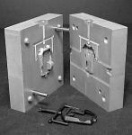 Hiebert
Hiebert
Sculpture Works
Oakland, California 94609
Phone: 510.654.7488
hsw@hieberts.com
Home
Contact
About HSW
EXAMPLES:
Parts: 1
Parts: 2
Parts: 3
Sculpture
Tooling
Links
Report
problems to:
webmaster@hieberts.com
Plastic Injection Molding
EPOXY TOOLING
(Overview):
Epoxy tooling is a fast and economical method of producing plastic parts.
It is an option available to engineers, designers, and others who require
a limited quantity of plastic components. An epoxy tool or mold is produced by casting an epoxy compound against
a pattern. The pattern represents the shape and form of the plastic
part that is needed. The epoxy compound is a mixture of epoxy resin, metal
particles, and curing agents. These are specially formulated for strength,
temperature resistance, and other properties required during the plastic
injection process. Patterns can be almost any hard, stable material
such as wood, plaster, plastic, metal, etc. The harder, more durable materials
such as plastic and metal are preferred. Stereolithogaphy patterns
are often used because of their low cost and rapid production. The primary advantage
of epoxy tooling is its ability to quickly and accurately replicate intricate
shapes and textures. Plastic parts made with the aid of epoxy tooling
can help speed the product development cycle. A well-made epoxy mold
can produce several thousand parts using standard injection molding resins.
These parts may be used for testing, design verification, sales samples,
product promotion, and limited production.
Typical Tooling: Click image for enlargement and comments.
